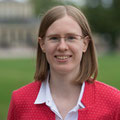Research Group of Prof. Dr. Barbara Verfürth

Contact Information
Friedrich-Hirzebruch-Allee 7
53115 Bonn
Germany
Research interests
- numerical methods for partial differential equations
- multiscale (finite element) methods
- (numerical) homogenization
- (time-harmonic) wave propagation: Helmholtz and Maxwell equations
- nonlinear PDEs (nonlinear diffusion, nonlinear Helmholtz,…)
Short CV
- since 10/2022: Professor at INS, University of Bonn
- 2020 – 2022: Junior research group leader and Tenure-Track-Professor at Karlsruhe Institute of Technology (KIT)
- 2018 – 2020: PostDoc at University of Augsburg
- 2015 – 2018: PhD at University of Münster
Teaching
Winter semester 2025/26
Summer semester 2025
Winter semester 2024/25
See teaching activities of the whole group.
Research Projects
Current
Numerical homogenization of multiscale problems with coupled scales
Project B04, CRC1720.
Numerical methods for nonlinear, random and dynamical multiscale problems
Project 496556642, DFG Emmy Noether.
Metamaterials are modern, artificially constructed materials that are tailored to exhibit new, astonishing physical properties. Therefore, they play a decisive role to control and manipulate waves, for instance in laser applications. Metamaterials are characterized by fine structures of different material components. The typical length of these fine structures is much smaller than the length of the whole material bulk. Further important building blocks in applications are nonlinear material responses and time modulation. Finally, the robustness of the material properties with respect to imperfections in the fabrication process is highly relevant. Within mathematical models, these applications lead to partial differential equations with a coexistence of multiple temporal and spatial scales, nonlinearities, and random perturbations. Numerical simulations have very high potential in the material design as they can replace time-consuming and costly experiments. Yet, standard numerical methods need to resolve all fine material structures so that their computational effort is prohibitive even with today’s computer resources. In contrast, computational multiscale methods (CMMs) deliver a macroscopic representation of the solution by suitable local upscaling processes. However, the incorporation of nonlinearities, random perturbations, and multiscale dynamics require new computational paradigms for several reasons. Firstly, CMMs often rely on linear arguments that break down for nonlinear problems. Thus, most approaches propose to couple nonlinear problems on fine and macroscopic scales in a rather complicated manner. Secondly, Monte Carlo techniques require many multiscale simulations with new, rather costly upscaling processes for each random sample. Present approaches at least for the numerical analysis additionally rely on stochastic homogenisation results. Thirdly, CMMs for dynamical problems mostly treat multiple spatial or multiple temporal scales exclusively.In this project, we develop and analyse novel CMMs to tackle nonlinear, randomly perturbed, and dynamical problems. The main goals are connected to fundamental mathematical and computational challenges requiring a revolutionary coalescence of multiscale methods, model reduction, uncertainty quantification, and time integration. We (a) explore adaptive linearised and nonlinear approximation spaces for nonlinear multiscale problems, (b) unite multiscale methods and Monte Carlo approaches for randomly perturbed problems, and (c) bridge spatial and temporal multiscale methods for rapid multiscale dynamics. While the general nature of our approaches allows their application to a wide range of problems, we put special emphasis on wave-related phenomena. Moreover, we rigorously justify all methods by error estimates which is crucial beyond the experimentally validated regime. Ultimately, this project will push forward the frontiers of CMMs for realistic (metamaterial) applications.
Completed
TEEMLEAP - A new TEstbed for Exploring Machine LEarning in Atmospheric Prediction
KIT Future Fields.
See all projects of the group.
Publications
Preprints
-
Articles
-
-
-
-
TEEMLEAP - a new testbed for exploring machine learning in atmospheric prediction for research and education.
J. Wilhelm, J. F. Quinting, M. Burba, S. Hollborn, U. Ehret, I. P. Sanchez, S. Lerch, J. Meyer, B. Verfürth, and P. Knippertz.
Journal of Advances in Modeling Earth Systems, 17(7):e2024MS004881, 2025.
BibTeX
DOI
preprint
-
-
-
Two-step homogenization of spatiotemporal metasurfaces using an eigenmode-based approach.
P. Garg, A. G. Lamprianidis, S. Rahman, N. Stefanou, E. Almpanis, N. Papanikolaou, B. Verfürth, and C. Rockstuhl.
Opt. Mater. Express, 14(2):549–563, 2024.
See supplement https://doi.org/10.6084/m9.figshare.24849822.v2.
BibTeX
DOI
-
-
-
-
-
-
-
-
-
-
-
-
-
-
-
-
-
-
-
-
Proceedings
-
-
-
Computational multiscale method for nonlinear monotone elliptic equations.
B. Verfürth.
In Oberwolfach Reports, number 35. 2019.
BibTeX
-
-
Thesis
-
TEEMLEAP - a new testbed for exploring machine learning in atmospheric prediction for research and education. J. Wilhelm, J. F. Quinting, M. Burba, S. Hollborn, U. Ehret, I. P. Sanchez, S. Lerch, J. Meyer, B. Verfürth, and P. Knippertz. Journal of Advances in Modeling Earth Systems, 17(7):e2024MS004881, 2025. BibTeX DOI preprint
-
Two-step homogenization of spatiotemporal metasurfaces using an eigenmode-based approach. P. Garg, A. G. Lamprianidis, S. Rahman, N. Stefanou, E. Almpanis, N. Papanikolaou, B. Verfürth, and C. Rockstuhl. Opt. Mater. Express, 14(2):549–563, 2024. See supplement https://doi.org/10.6084/m9.figshare.24849822.v2. BibTeX DOI
-
Computational multiscale method for nonlinear monotone elliptic equations. B. Verfürth. In Oberwolfach Reports, number 35. 2019. BibTeX